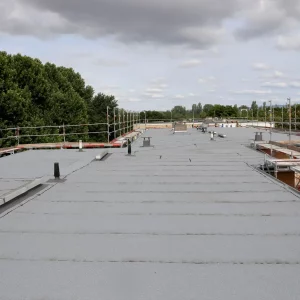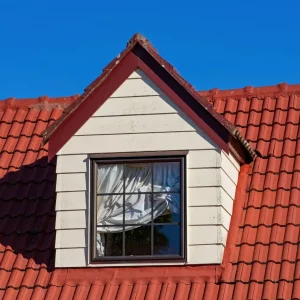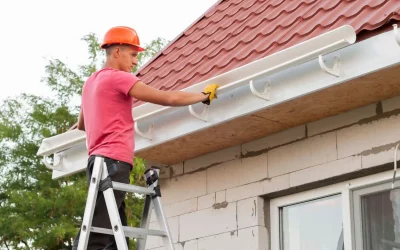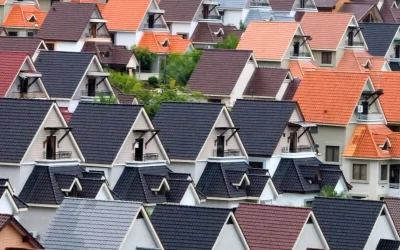When building or renovating a home, one of the most critical decisions you’ll make is choosing the right roof style. Flat roofs and pitched roofs each have distinct advantages and drawbacks, making it essential to understand their differences before making a decision. In this article, we’ll explore the key factors to consider when deciding between a flat roof and a pitched roof.
Understanding Flat Roof
A flat roof is a roofing system that has little to no slope, typically with a pitch of about 1-10 degrees. While they may appear completely level, they are slightly angled to allow for water drainage.
Pros of Flat Roof
- Cost-Effective – typically require fewer materials and are quicker to install, reducing overall costs.
- Modern Aesthetic – Many contemporary homes feature flat roofs, offering a sleek and minimalist design.
- Usable Space – A flat roof can be utilized for additional outdoor living space, such as a rooftop patio or garden.
- Easier Maintenance – Since flat roofs are more accessible, inspections, repairs, and installations (such as solar panels) are easier to perform.
- Versatility – Flat roofs can accommodate HVAC systems, solar panels, or even green roofing solutions.

Cons of Flat Roof
- Drainage Issues – Without a significant slope, water can pool on the surface, leading to leaks or structural damage if not properly maintained.
- Limited Lifespan – Flat roofs tend to have a shorter lifespan compared to pitched roofs, often requiring replacement sooner.
- Insulation Challenges – They are less effective at insulating a home, potentially leading to higher heating and cooling costs.
- Material Limitations – Flat roofs often require specific materials, such as rubber or PVC membranes, which may need more frequent maintenance.
Understanding Pitched Roof
A pitched roof features a steep slope, typically with two or more sides meeting at a peak. This traditional roofing style is commonly seen in residential homes.
Pros of Pitched Roof
- Superior Drainage – The slope allows water, snow, and debris to run off easily, reducing the risk of leaks.
- Longevity – Pitched roofs often last longer than flat roofs due to their durability and weather resistance.
- Energy Efficiency – The structure allows for better insulation, improving energy efficiency and lowering utility costs.
- Classic Appeal – Pitched roofs have a timeless aesthetic, blending well with various architectural styles.
- Increased Attic Space – Many pitched roofs create additional attic space, which can be used for storage or converted into living areas.
- Higher Property Value – Due to their durability and classic look, homes with pitched roofs often have higher resale value.

Cons of Pitched Roof
- Higher Cost – The complexity of pitched roofs requires more materials and labor, making them more expensive upfront.
- Difficult Maintenance – Due to the steep incline, maintenance and repairs can be challenging and may require professional help.
- Limited Design Flexibility – Unlike flat roofs, pitched roofs are not ideal for additional outdoor spaces like rooftop gardens.
- Longer Installation Time – Pitched roofs take longer to install, which could extend the construction timeline of a home.
Choosing the Right Roof for Your Home
When deciding between a flat roof and a pitched roof, consider the following factors:
Climate & Weather Conditions
- If you live in an area with heavy rain or snowfall, a pitched roof is preferable for efficient drainage.
- Flat roofs are more common in dry, warm climates where water accumulation is less of a concern.
- In hurricane-prone areas, pitched roofs with proper reinforcements may withstand extreme winds better than flat roofs.
Budget
- If cost is a primary concern, a flat roof is generally more affordable in terms of materials and installation.
- However, while pitched roofs have a higher initial cost, they often provide better long-term value due to their durability and longevity.
- Consider future maintenance costs when budgeting, as flat roofs may require more frequent repairs.
Aesthetic Preference
- Flat roofs suit modern and minimalist designs, whereas pitched roofs complement traditional and classic home styles.
- Some homeowners prefer the dramatic look of a steeply pitched roof, while others enjoy the clean lines of a flat roof.
Usage & Functionality
- If you envision an outdoor entertainment space or a green roof, a flat roof offers more usability.
- If insulation, longevity, and weather resistance are priorities, a pitched roof is the better option.
- Pitched roofs provide extra attic storage or the possibility of additional living space.
Resale Value
- Pitched roofs generally add more value to a home due to their durability and classic appeal.
- Flat roofs, while stylish and modern, may require a niche market of buyers looking for contemporary homes.
Which Roof Style is Best for You?
Both flat roofs and pitched roofs offer unique benefits, and the right choice depends on your specific needs, budget, and environmental conditions. Flat roofs provide cost savings and modern appeal, while pitched roofs excel in durability, insulation, and drainage.
If you’re still unsure about which roofing option is best for your home, Quick Roofing is here to help! Our expert team can assess your needs and provide professional guidance to ensure you make the best decision for your home’s structure and long-term value. Contact us today for a consultation!




